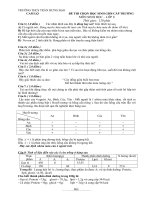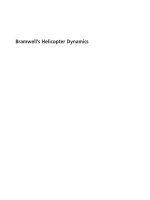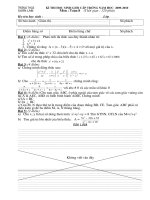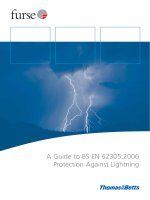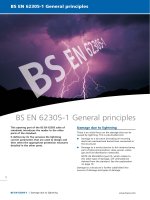Bsi bs en 00438 8 2009
Bạn đang xem bản rút gọn của tài liệu. Xem và tải ngay bản đầy đủ của tài liệu tại đây (339.4 KB, 20 trang )
BRITISH STANDARD
High-pressure
decorative laminates
(HPL) — Sheets based
on thermosetting
resins (Usually called
Laminates)
Part 8: Classification and
specifications for design laminates
ICS 83.140.20
NO COPYING WITHOUT BSI PERMISSION EXCEPT AS PERMITTED BY COPYRIGHT LAW
BS EN 438-8:2009
BS EN 438-8:2009
National foreword
This British Standard is the UK implementation of EN 438-8:2009.
The UK participation in its preparation was entrusted to Technical
Committee PRI/76, Laminated sheet for decorative purposes.
A list of organizations represented on this committee can be obtained on
request to its secretary.
This publication does not purport to include all the necessary provisions
of a contract. Users are responsible for its correct application.
Compliance with a British Standard cannot confer immunity
from legal obligations.
This British Standard
was published under the
authority of the Standards
Policy and Strategy
Committee on 30 April
2009
© BSI 2009
ISBN 978 0 580 56686 8
Amendments/corrigenda issued since publication
Date
Comments
BS EN 438-8:2009
EUROPEAN STANDARD
EN 438-8
NORME EUROPÉENNE
EUROPÄISCHE NORM
March 2009
ICS 83.140.20
English Version
High-pressure decorative laminates (HPL) - Sheets based on
thermosetting resins (Usually called Laminates) - Part 8:
Classification and specifications for design laminates
Stratifiés décoratifs haute pression (HPL) - Plaques à base
de résines thermodurcissables (communément appelées
stratifiés) - Partie 8 : Classification et spécifications
relatives aux stratifiés à effets de surface spéciaux
Dekorative Hochdruck-Schichtpressstoffplatten (HPL) Platten auf Basis härtbarer Harze (Schichtpressstoffe) - Teil
8: Klassifizierung und Spezifikationen für DesignSchichtpressstoffe
This European Standard was approved by CEN on 22 February 2009.
CEN members are bound to comply with the CEN/CENELEC Internal Regulations which stipulate the conditions for giving this European
Standard the status of a national standard without any alteration. Up-to-date lists and bibliographical references concerning such national
standards may be obtained on application to the CEN Management Centre or to any CEN member.
This European Standard exists in three official versions (English, French, German). A version in any other language made by translation
under the responsibility of a CEN member into its own language and notified to the CEN Management Centre has the same status as the
official versions.
CEN members are the national standards bodies of Austria, Belgium, Bulgaria, Cyprus, Czech Republic, Denmark, Estonia, Finland,
France, Germany, Greece, Hungary, Iceland, Ireland, Italy, Latvia, Lithuania, Luxembourg, Malta, Netherlands, Norway, Poland, Portugal,
Romania, Slovakia, Slovenia, Spain, Sweden, Switzerland and United Kingdom.
EUROPEAN COMMITTEE FOR STANDARDIZATION
COMITÉ EUROPÉEN DE NORMALISATION
EUROPÄISCHES KOMITEE FÜR NORMUNG
Management Centre: Avenue Marnix 17, B-1000 Brussels
© 2009 CEN
All rights of exploitation in any form and by any means reserved
worldwide for CEN national Members.
Ref. No. EN 438-8:2009: E
BS EN 438-8:2009
EN 438-8:2009 (E)
Contents
Page
Foreword ..............................................................................................................................................................3
1
Scope ......................................................................................................................................................4
2
Normative references ............................................................................................................................4
3
Terms and definitions ...........................................................................................................................4
4
Material types and classification system ............................................................................................5
5
5.1
5.2
5.3
5.4
Requirements .........................................................................................................................................6
Compliance .............................................................................................................................................6
Inspection requirements .......................................................................................................................6
Dimensional tolerance requirements...................................................................................................7
Test requirements ............................................................................................................................... 11
Bibliography ..................................................................................................................................................... 17
2
BS EN 438-8:2009
EN 438-8:2009 (E)
Foreword
This document (EN 438-8:2009) has been prepared by Technical Committee CEN/TC 249 “Plastics”, the
secretariat of which is held by NBN.
This European Standard shall be given the status of a national standard, either by publication of an identical
text or by endorsement, at the latest by September 2009, and conflicting national standards shall be
withdrawn at the latest by September 2009.
Attention is drawn to the possibility that some of the elements of this document may be the subject of patent
rights. CEN [and/or CENELEC] shall not be held responsible for identifying any or all such patent rights.
EN 438 consists of the following parts, under the general title High-pressure decorative laminates (HPL) —
Sheets based on thermosetting resins (Usually called Laminates):
Part 1: Introduction and general information
Part 2: Determination of properties
Part 3: Classification and specifications for laminates less than 2 mm thick intended for bonding to
supporting substrates
Part 4: Classification and specifications for Compact laminates of thickness 2 mm and greater
Part 5: Classification and specifications for flooring grade laminates less than 2 mm thick intended for
bonding to supporting substrates
Part 6: Classification and specifications for Exterior-grade Compact laminates of thickness 2 mm and
greater
Part 7: Compact laminate and HPL composite panels for internal and external wall and ceiling finishes
Part 8: Classification and specifications for design laminates (this standard)
Part 9: Classification and specifications for alternative core laminates1
www.bzfxw.com
According to the CEN/CENELEC Internal Regulations, the national standards organizations of the following
countries are bound to implement this European Standard: Austria, Belgium, Bulgaria, Cyprus, Czech
Republic, Denmark, Estonia, Finland, France, Germany, Greece, Hungary, Iceland, Ireland, Italy, Latvia,
Lithuania, Luxembourg, Malta, Netherlands, Norway, Poland, Portugal, Romania, Slovakia, Slovenia, Spain,
Sweden, Switzerland and the United Kingdom.
1
In preparation.
3
BS EN 438-8:2009
EN 438-8:2009 (E)
1
Scope
This part of EN 438 specifies performance requirements for high-pressure decorative laminates (HPL)
intended for interior use with a design effect surface having a phenolic based core and a decorative surface,
not covered by EN 438-3 to EN 438-6. Three surface material types (metal, wood veneer and pearlescent
decor) are defined in this part of EN 438.
EN 438-2 specifies the test methods relevant to this part of EN 438.
2
Normative references
The following referenced documents are indispensable for the application of this document. For dated
references, only the edition cited applies. For undated references, the latest edition of the referenced
document (including any amendments) applies.
EN 438-2:2005, High-pressure decorative laminates (HPL) — Sheets based on thermosetting resins (usually
called Laminates) — Part 2: Determination of properties
EN 12721, Furniture — Assessment of surface resistance to wet heat (ISO 4211-2:1993 modified)
EN 12722, Furniture — Assessment of surface resistance to dry heat (ISO 4211-3:1993 modified)
EN ISO 178, Plastics — Determination of flexural properties (ISO 178:2001)
EN ISO 1183-1, Plastics — Methods for determining the density of non-cellular plastics — Part 1: Immersion
method, liquid pyknometer method and titration method (ISO 1183-1:2004)
www.bzfxw.com
ISO 11664-2, Colorimetry -- Part 2: CIE standard illuminants
3
Terms and definitions
For the purposes of this document, the following terms and definitions apply.
3.1
high pressure process
process for producing laminate(s) by simultaneous application of heat (temperature ≥ 120 °C) and high
specific pressure (≥ 5 MPa), to provide flowing and subsequent curing of the thermosetting resins
3.2
high-pressure decorative design laminate(s) (HPL)
sheet(s) consisting of decorative surface layers supported by layers of cellulosic fibrous material (normally
paper) impregnated with thermosetting resins and bonded together by a high pressure process
NOTE 1
For surface layers, see 3.3.
NOTE 2
The core layers are impregnated with phenolic based resins. The surface layers can appear on one or both
side(s) of the laminate(s). They are not necessarily treated with thermosetting resin. In case of one-sided design laminates
the back of the sheet(s) is made suitable for adhesive bonding to a substrate.
3.3 Types of high-pressure decorative design laminates according to the surface layer materials
3.3.1
pearlescent laminate
high-pressure decorative design laminate, the surface material of which consists of a pearlescent effect
decorative paper, which is impregnated with melamine resin
4
BS EN 438-8:2009
EN 438-8:2009 (E)
NOTE 1
To achieve the optimum aesthetic effect from the pearlescent pigment a protective melamine layer is not used.
NOTE 2
As a result some surface properties are reduced (e.g. scratch, wear) therefore it is recommended that these
products are used for vertical applications.
3.3.2
metal laminate
high-pressure decorative design laminate, the surface material of which consists of a thin layer of metal
NOTE 1
E.g. aluminium, steel or copper.
NOTE 2
It is often protected by a thin layer of lacquer or in the case of aluminium the surface can be anodized. The
surface performance and appearance of these metal laminates is equivalent to that of thin metal sheet.
NOTE 3
As some surface properties are lower than that of melamine (e.g. scratch and wear), it is recommended that
these products are used for vertical applications.
3.3.3
wood veneer laminate
high-pressure decorative design laminate, the surface material of which consists of a wood veneer, which is
covered by a protective melamine layer. The surface appearance of these wood veneer laminates is similar to
wood. Wood veneer laminates are not normally available in postforming grade
4
Material types and classification system
High-pressure decorative design laminates are defined using a three letter classification system as shown in
Table 1.
www.bzfxw.com
Table 1 — High-pressure decorative design laminate classification system
First letter
Second letter
A
(Pearlescent laminate)
C
(Compact)
M
(Metal laminate)
T
(Thin laminate < 2 mm)
W
(Wood veneer laminate)
Third letter
S (Standard grade)
or P (Postformable grade)
or F (Flame retardant grade)
Type S – Standard grade high-pressure decorative design laminates.
Type P – Postformable high-pressure decorative design laminates, similar to type S but can also be formed at
elevated temperature.
Type F – High-pressure decorative design laminates with improved fire retardance similar to type S or P but
also complying with special requirements of specified tests which may vary according to the application
(e.g. construction, marine, transport) and the country of use (see 5.4.5).
In addition to the abbreviation "HPL" and the number of this European Standard, materials shall be specified
by the alphabetical classification system.
EXAMPLE
"Pearlescent Standard Grade Thin high-pressure decorative design laminate" is designated as
HPL/EN 438-8 ATS.
5
BS EN 438-8:2009
EN 438-8:2009 (E)
5
Requirements
5.1
Compliance
High-pressure decorative design laminates classified in Table 1 shall comply with all appropriate requirements
specified in 5.2, 5.3 and 5.4. This applies to both full-size sheets and cut-to-size panels.
5.2
Inspection requirements
5.2.1
General
Inspection shall be carried out in accordance with EN 438-2:2005, Clause 4, at a distance of 1,5 m.
5.2.2
5.2.2.1
Colour, pattern and surface finish
Pearlescent
When inspected in daylight or D65 standard illuminant, as specified in ISO 11664-2, and also under tungstenfilament lightning illuminant A as specified in ISO 11664-2, a slight difference between the corresponding
colour reference sample held by the supplier and the specimen under test is acceptable.
As colour and surface finish are critical, it is recommended that sheets are checked for colour and surfacefinish compatibility without protective film before fabrication or installation.
Some of these products are directional in surface finish or colour and they shall be installed in the correct
orientation.
5.2.2.2
Metal
www.bzfxw.com
When inspected in daylight or D65 standard illuminant, as specified in ISO 11664-2, and also under tungstenfilament lightning illuminant A as specified in ISO 11664-2, a slight difference between the corresponding
colour reference sample held by the supplier and the specimen under test is acceptable.
As colour and surface finish are critical, it is recommended that sheets are checked for colour and surfacefinish compatibility without protective film before fabrication or installation.
Some of these products are directional in surface finish or colour and they shall be installed in the correct
orientation. Small indentations in the surface are unavoidable.
5.2.2.3
Wood veneer
Due to the fact that wood is a natural product, each veneer may be considered as unique. Slight colour and
structure differences are considered as normal. Singularities such as knots and resin inclusions are not
considered as defects, but as a part of the decor. There are differences in light fastness performances
depending on the wood species and the source of the wood.
5.2.3
Reverse side
The reverse side of single-sided sheets shall be suitable for adhesive bonding (e.g. sanded). In the case of
sanded backs, slight chatter marks shall be permitted.
6
BS EN 438-8:2009
EN 438-8:2009 (E)
5.2.4
Visual inspection
5.2.4.1
General
The following inspection requirements are intended as a general guide, indicating the minimum acceptable
quality for laminates. Cut-to-size panels and certain applications involving full-size sheets may call for special
quality requirements which can be negotiated between supplier and purchaser; in such cases the following
requirements may be used as a basis for agreement. Only a small percentage of sheets in a batch (the level
to be agreed with the customer) shall contain defects of the minimum acceptable level.
5.2.4.2
Surface quality
The following surface defects are permissible:
Dirt, spots, dents and similar surface defects
2
2
The admissible size of such defects is based on a maximum contamination area equivalent to 1,0 mm /m of
laminate and is proportional to the sheet size under inspection.
The total admissible area of contamination may be concentrated in one spot or dispersed over an unlimited
amount of smaller defects.
Fibres, hairs and scratches
2
The admissible size of defects is based on a maximum contamination length equivalent to 10 mm/m of
laminate and is proportional to the sheet size under inspection.
www.bzfxw.com
The total admissible length of contamination may be concentrated in one defect or dispersed over an
unlimited amount of smaller defects.
5.2.4.3
Edge quality
Visual defects (e.g. moisture marks, lack of gloss, corner damage) can be present on all four edges of the
laminate, providing the defect-free length and width are at least the nominal size minus 20 mm.
5.3
5.3.1
Dimensional tolerance requirements
Dimensional tolerance requirements for pearlescent laminates
Dimensional tolerance requirements for pearlescent laminates are specified in Tables 2 and 3.
7
BS EN 438-8:2009
EN 438-8:2009 (E)
Table 2 — Dimensional tolerance requirements for thin pearlescent laminates
Property
Test method
Requirement
(EN 438-2:2005
clause no.)
Thickness
5
0,5 mm ≤ t ≤ 1,0 mm: maximum variation ± 0,10 mm
1,0 mm < t < 2,0 mm: maximum variation ± 0,15 mm
(where t = nominal thickness of the pearlescent laminate)
Flatness a
9
maximum deviation: 60 mm/m
Length and width b
6
+ 10 mm / - 0 mm
Straightness of edges b
7
Maximum deviation: 1,5 mm/m
Squareness b
8
Maximum deviation: 1,5 mm/m
a Provided that the perlescent laminates are stored in the manner and conditions recommended by the manufacturer they shall
comply with the flatness requirements specified in Table 2 when measured in accordance with EN 438-2:2005, Clause 9.
b Tolerances for cut-to-size panels shall be agreed between supplier and purchaser.
Table 3 — Dimensional tolerance requirements for compact pearlescent laminates
Property
Test method
(EN 438-2:2005
clause no.)
Thickness
5
Requirement
www.bzfxw.com
2,0 mm ≤ t < 3,0 mm: maximum variation ± 0,20 mm
3,0 mm ≤ t < 5,0 mm: maximum variation ± 0,30 mm
5,0 mm ≤ t < 8,0 mm: maximum variation ± 0,40 mm
8,0 mm ≤ t < 12,0 mm: maximum variation ± 0,50 mm
12,0 mm ≤ t < 16,0 mm: maximum variation ± 0,60 mm
16,0 mm ≤ t < 20,0 mm: maximum variation ± 0,70 mm
20,0 mm ≤ t < 25,0 mm: maximum variation ± 0,80 mm
25,0 mm < t : to be agreed between supplier and customer
(where t = nominal thickness of the pearlescent laminate)
Flatness a
9
2,0 mm ≤ t < 6,0 mm: 8,0 mm/m maximum deviation
6,0 mm ≤ t < 10,0 mm: 5,0 mm/m maximum deviation
10,0 mm ≤ t : 3,0 mm/m maximum deviation
(where t = nominal thickness of the pearlescent laminate)
8
Length and width b
6
+ 10 mm / - 0 mm
Straightness of edges b
7
Maximum deviation: 1,5 mm/m
Squareness b
8
Maximum deviation: 1,5 mm/m
a
Provided that the perlescent laminates are stored in the manner and conditions recommended by the manufacturer they shall
comply with the flatness requirements specified in Table 3 when measured in accordance with EN 438-2:2005, Clause 9. The
flatness values specified in Table 3 apply to perlescent laminates with two decorative faces. Limits for pearlescent laminates
with one face sanded shall be agreed between supplier and customer.
b
Tolerances for cut-to-size panels shall be agreed between supplier and purchaser.
BS EN 438-8:2009
EN 438-8:2009 (E)
5.3.2
Dimensional tolerances requirements for metal laminates
Dimensional tolerance requirements for metal laminates are specified in Tables 4 and 5
Table 4 — Dimensional tolerance requirements for thin metal laminates
Property
Test method
Requirement
(EN 438-2:2005
clause no.)
Thickness
5
0,5 mm ≤ t ≤ 1,0 mm: maximum variation ± 0,15 mm
1,0 mm < t < 2,0 mm: maximum variation ± 0,18 mm
(where t = nominal thickness of the metal laminate)
Flatness a
9
Maximum deviation: 100 mm/m
Length and width b
6
+ 10 mm / - 0 mm
Straightness of edges b
7
Maximum deviation: 1,5 mm/m
Squareness b
8
Maximum deviation: 1,5 mm/m
a
Provided that the metal laminates are stored in the manner and conditions recommended by the manufacturer they shall comply
with the flatness requirements specified in Table 4 when measured in accordance with EN 438-2:2005, Clause 9.
b
Tolerances for cut-to-size panels shall be agreed between supplier and purchaser.
Table 5 — Dimensional tolerance requirements for compact metal laminates
Property
Test method
Requirement
(EN 438-2:2005
clause no.)
Thickness
5
2,0 mm ≤ t < 3,0 mm: maximum variation ± 0,25 mm
3,0 mm ≤ t < 5,0 mm: maximum variation ± 0,40 mm
5,0 mm ≤ t < 8,0 mm: maximum variation ± 0,50 mm
8,0 mm ≤ t < 12,0 mm: maximum variation ± 0,70 mm
12,0 mm ≤ t < 16,0 mm: maximum variation ± 0,80 mm
16,0 mm ≤ t < 20,0 mm: maximum variation ± 0,90 mm
20, 0 mm < t < 25,0 mm: maximum variation ± 1,00 mm
25,0 mm < t : to be agreed between supplier and customer
(where t = nominal thickness of the metal laminate)
Flatness a
9
2,0 mm ≤ t < 6,0 mm: 8,0 mm/m maximum deviation
6,0 mm ≤ t < 10,0 mm: 5,0 mm/m maximum deviation
10,0 mm ≤ t : 3,0 mm/m maximum deviation
(where t = nominal thickness of the metal laminate)
Length and width b
6
+ 10 mm / - 0 mm
Straightness of edges b
7
Maximum deviation: 1,5 mm/m
Squareness b
8
Maximum deviation: 1,5 mm/m
a
Provided that the metal laminates are stored in the manner and conditions recommended by the manufacturer they shall comply
with the flatness requirements specified in Table 5 when measured in accordance with EN 438-2:2005, Clause 9. The flatness values
specified in Table 5 apply to metal laminates with two decorative faces. Limits for metal laminates with one face sanded shall be
agreed between supplier and customer.
b
Tolerances for cut-to-size panels shall be agreed between supplier and purchaser.
9
BS EN 438-8:2009
EN 438-8:2009 (E)
5.3.3
Dimensional tolerance requirements for wood veneer laminates
Dimensional tolerance requirements for wood veneer laminates are specified in Tables 6 and 7.
Table 6 — Dimensional tolerance requirements for thin wood veneer laminates
Property
Test method
Requirement
(EN 438-2:2005
clause no.)
Thickness
5
(0,5 mm ≤ t ≤ 1,0) mm: maximum variation ± 0,15 mm
(1,0 mm < t < 2,0) mm: maximum variation ± 0,18 mm
(where t = nominal thickness of the wood veneer laminate)
Flatness a
9
Maximum deviation: 120 mm/m
Length and width b
6
+ 10 mm / - 0 mm
Straightness of edges b
7
Maximum deviation: 1,5 mm/m
Squareness b
8
Maximum deviation: 1,5 mm/m
a
Provided that the wood veneer laminates are stored in the manner and conditions recommended by the manufacturer they shall
comply with the flatness requirements specified in Table 6 when measured in accordance with EN 438-2:2005, Clause 9.
b
Tolerances for cut-to-size panels shall be agreed between supplier and purchaser.
10
BS EN 438-8:2009
EN 438-8:2009 (E)
Table 7 — Dimensional tolerance requirements for compact wood veneer laminates
Property
Test method
Requirement
(EN 438-2:2005
clause no.)
Thickness
5
2,0 mm ≤ t < 3,0 mm: maximum variation ± 0,25 mm
3,0 mm ≤ t < 5,0 mm: maximum variation ± 0,40 mm
5,0 mm ≤ t < 8,0 mm: maximum variation ± 0,50 mm
8,0 mm ≤ t < 12,0 mm: maximum variation ± 0,70 mm
12,0 mm ≤ t < 16,0 mm: maximum variation ± 0,80 mm
16,0 mm ≤ t < 20,0 mm: maximum variation ± 0,90 mm
20, 0 mm < t < 25,0 mm: maximum variation ± 1,00 mm
25,0 mm < t: to be agreed between supplier and customer
(where t = nominal thickness of the wood veneer
laminate)
Flatness a
9
2,0 mm ≤ t < 6,0 mm: 12,0 mm/m maximum deviation
6,0 mm ≤ t < 10,0 mm: 8,0 mm/m maximum deviation
10,0 mm ≤ t : 5,0 mm/m maximum deviation
(where t = nominal thickness of the wood veneer
laminate)
Length and width b
6
+ 10 mm / - 0 mm
Straightness of edges b
7
Maximum deviation: 1,5 mm/m
Squareness b
8
Maximum deviation: 1,5 mm/m
a
Provided that the wood veneer laminates are stored in the manner and conditions recommended by the manufacturer
they shall comply with the flatness requirements specified in Table 7 when measured in accordance with EN 438-2:2005,
Clause 9. The flatness values specified in Table 7 apply to wood veneer laminates with two decorative faces. Limits for wood
veneer laminates with one face sanded shall be agreed between supplier and customer.
b
5.4
5.4.1
Tolerances for cut-to-size panels shall be agreed between supplier and purchaser.
Test requirements
General requirements for pearlescent laminates
General requirements specified in Table 8.
11
BS EN 438-8:2009
EN 438-8:2009 (E)
Table 8 — General requirements for pearlescent laminates
Property
Test method
(EN 4382:2005 clause
no. unless
otherwise
stated)
Resistance to
impact by small
diameter ball
20
Resistance to
impact by large
diameter ball
21
Resistance to
scratching
Dimensional
stability at elevated
temperature
Pearlescent laminate grade
Property or
attribute
Spring force
Drop height
25 and
EN 4383:2005,
Annex A
17
Unit
(max. or min.)
N (min.)
mm (min.)
Indent
diameter
mm (max.)
Force
Rating (min.)
Cumulative
dimensional
change
ATS
ATP
ATF
ACS
ACF
15
15
15
–
–
–
–
–
800
800
12
12
2
2
2
2
2
% (max.)
La
0,75
0,75
0,75
–
–
t < 2 mm
Tb
1,25
1,25
1,25
–
–
2 mm < t < 5 mm La
–
–
–
0,40
0,40
Tb
–
–
–
0,80
0,80
La
–
–
–
0,30
0,30
Tb
–
–
–
0,60
0,60
gloss finish
3
3
3
3
3
other finishes
4
4
4
4
4
2 mm < t < 5 mm
–
–
–
5,0
7,0
t > 5 mm
–
–
–
2,0
3,0
2 mm < t < 5 mm
–
–
–
6,0
9,0
t > 5 mm
–
–
–
2,0
6,0
Groups 1 and 2
5
5
5
5
5
Group 3
4
4
4
4
4
t > 5 mm
Rating (min.)
Appearance
Resistance to
immersion in
boiling water
% (max.)
12
Mass increase
% (max.)
Thickness
increase
Rating (min.)
Resistance to
staining
26
Appearance
Light fastness
(xenon arc)
27
Contrast
Grey scale rating (min.)
4c
4c
4c
4c
4c
Resistance to water
vapour
14
Appearance
Rating (min.)
3
3
3
3
3
Resistance to
cracking under
stress (optional)
23
Appearance
Rating (min.)
4
4
4
–
–
12
BS EN 438-8:2009
EN 438-8:2009 (E)
Table 8 (Continued)
Resistance to
crazing
24
Appearance
Rating (min.)
–
–
–
4
4
Flexural strength
EN ISO 178d
Stress
MPa (min.)
–
–
–
80
Flexural modulus
EN ISO 178 d
Stress
MPa (min.)
–
–
–
9 000
Density
EN ISO 11831
Density
g/cm (min)
3
1,35
1,35
1,35
1,35
1,35
a
L = in the longitudinal (or machine) direction of the fibrous sheet material (normally the direction of the longest dimension of the
perlescent laminate).
b
T = in the cross-longitudinal (cross-machine) direction of the fibrous sheet material (at right angles to direction L).
c
Extraneous darkening and/or photocromism are due to the shock effect of accelerated exposure and are not characteristics of natural
exposure.
d
Machined crosshead speed: 2 mm/min.
13
BS EN 438-8:2009
EN 438-8:2009 (E)
5.4.2
General requirements for metal laminates
General requirements specified in Table 9.
Table 9 — General requirements for metal laminates
Property
Resistance to
scratching
Test method
(EN 4382:2005
clause no.
unless
otherwise
stated)
25
Metal laminate grade
Unit
Property or
attribute
Force
(max. or min.)
MTS
MTP
MTF
MCS
MCF
1
1
1
1
1
La
0,75
0,75
0,75
–
–
Tb
1,25
1,25
1,25
–
–
La
–
–
–
0,40
0,40
Tb
–
–
–
0,80
0,80
La
–
–
–
0,30
0,30
Tb
–
–
–
0,60
0,60
Passc
Passc
Passc
Passc
Passc
Groups 1 and 2
4
4
4
4
4
Group 3
4
4
4
4
4
Rating (min.)
% (max.)
t < 2 mm
Dimensional
stability at
elevated
temperature
17
Cumulative
dimensional
change
2 mm < t < 5 mm
t > 5 mm
Resistance to
immersion in
boiling water
12
Appearance
Core delamination
Pass or fail
Rating (min.)
Resistance to
staining
26
Appearance
Light fastness
(xenon arc)
27
Contrast
Grey scale rating (min.)
4d
4d
4d
4d
4d
Resistance to
water vapour
14
Appearance
Rating (min.)
3
3
3
3
3
Resistance to
cracking under
stress (optional)
23
Appearance
Rating (min.)
4
4
4
–
–
Resistance to
crazing
24
Appearance
Rating (min.)
–
–
–
4
4
Flexural strength
EN ISO 178e
Stress
MPa (min.)
–
–
80
Flexural modulus
EN ISO 178e
Stress
MPa (min.)
–
–
9 000
EN ISO
1183-1
Density
g/cm (min.)
3
1,35
1,35
Density
1,35
1,35
1,35
a
L = in the longitudinal (or machine) direction of the fibrous sheet material (normally the direction of the longest dimension of the
metal laminate).
b
T=
c
No delamination of the core.
in the cross-longitudinal (cross-machine) direction of the fibrous sheet material (at right angles to direction L).
d
Extraneous darkening and/or photocromism are due to the shock effect of accelerated exposure and are not characteristics of natural
exposure.
e
Machined crosshead speed: 2 mm/min.
14
BS EN 438-8:2009
EN 438-8:2009 (E)
5.4.3
General requirements for wood veneer laminates
General requirements specified in Table 10.
Table 10 — General requirements for wood veneer laminates
Test method
(EN 4382:2005
clause no.
unless
otherwise
stated)
Property
Wood veneer laminate grade
Unit
Property or
attribute
(max or min)
WTS
WTF
WCS
WCF
initial point
150
150
150
150
wear value
350
350
350
350
Drop height
mm (min.)
600
600
800
800
Indent diameter
mm (max.)
12
12
10
10
Force
Rating (min.)
2
2
2
2
revolutions (min.)
Resistance to surface
wear
10
Resistance to impact
by large diameter ball
(optional)
21
Resistance
scratching
25
to
Dimensional stability at
elevated temperature
17
Wear
resistance
Cumulative
dimensional
change
% (max.)
La
0,75
0,90
–
–
t < 2 mm
Tb
1,25
1,40
–
–
2 mm < t < 5 mm La
–
–
0,55
0,55
Tb
–
–
0,90
0,90
La
–
–
0,45
0,45
Tb
–
–
0,75
0,75
Passc
Passc
Passc
Passc
t > 5 mm
Resistance
immersion in
water
to
boiling
12
Appearance
Delamination pass or fail
Resistance to dry heat
(100 °C)
EN 12722
Appearance
Rating (min.)
3
3
3
3
Resistance to wet heat
(100 °C)
EN 12721
Appearance
Rating (min.)
3
3
3
3
Groups 1 and 2
4
4
4
4
Group 3
4
4
4
4
Rating (min.)
Resistance to staining
26
Appearance
Light fastness (xenon
arc)
27
Contrast
Grey scale rating (min.)
2d
2d
2d
2d
Resistance to cracking
under stress (optional)
23
Appearance
Rating (min.)
4
4
–-
–
Resistance to crazing
24
Appearance
Rating (min.)
–
–
4
4
Flexural strength
EN ISO 178e
Stress
MPa (min.)
–
–
65
Flexural modulus
EN ISO 178e
Stress
MPa (min.)
–
–
6 500
EN ISO
1183-1
Density
g/cm (min.)
3
1,0
1,0
Density
1,1
1,1
15
BS EN 438-8:2009
EN 438-8:2009 (E)
Table 10 (Continued)
a
L = in the longitudinal (or machine) direction of the fibrous sheet material (normally the direction of the longest dimension of the
wood veneer laminate).
b
T=
c
No delamination of the core.
d
See 5.2.2.3.
e
Machined crosshead speed: 2 mm/min.
5.4.4
in the cross-longitudinal (cross-machine) direction of the fibrous sheet material (at right angles to direction L).
Additional requirements for type P high-pressure decorative design laminates.
In addition to meeting the appropriate requirements specified in Tables 8 and 9, Type P postformable
pearlescent laminates and metal laminates of thickness ≤ 1,5 mm shall meet the values specified in Table 11
for formability and blister resistance.
NOTE
Metal laminates are processed and tested at a lower temperature than typical postformable laminates.
Table 11 — Additional requirements for type P high-pressure decorative design laminates
Property
Formability
Resistance to
blistering
Test method
(EN 4382:2005, clause
no.)
31 or 32
33 or 34
Property or attribute
Unit
Radius
mm
Time to blister
(t2 - t1)
L
a
T
b
≤ 10 x laminate nominal
thickness
≤ 20 x laminate nominal
thickness
Seconds
Nominal thickness < 0,8 mm
≥ 10
Nominal thickness ≥ 0,8 mm
≥ 15
a
L=
axis of bending parallel to the fibre direction (usually parallel to the direction of sanding).
b
T=
axis of bending at right angles to the fibre direction.
5.4.5
Requirement
Notes on requirements for reaction to fire
The requirements for reaction to fire are determined by the fire regulations of the country in which the material
is to be used.
In Europe, laminate panels intended for construction applications are tested in accordance with EN 13823 [1]
(SBI test) and EN ISO 11925-2 [2] (Small-burner test), and the resulting reaction-to-fire performance is
expressed in accordance with EN 13501-1 [3].
For applications other than construction, fire test methods and performance requirements may vary from one
country to another, and at present it is not possible, with any test, to predict compliance with all national and
other requirements.
All the products covered by this part of EN 438 will have different reaction to fire performance depending on
the composition and/or decorative surfaces. Reaction to fire will also depend on laminate thickness and
construction of the element, substrate type and thickness, and adhesive used. The laminate manufacturer
should be contacted for information on fire test methods, classifications and fire certification.
No fire performance test is therefore included in this part of EN 438.
16
BS EN 438-8:2009
EN 438-8:2009 (E)
Bibliography
[1]
EN 13823, Reaction to fire tests for building products — Building products excluding floorings exposed
to the thermal attack by a single burning item
[2]
EN ISO 11925-2, Reaction to fire tests — Ignitability of building products subjected to direct
impingement of flame – Part 2: Single-flame source test (ISO 11925-2:2002)
[3]
EN 13501-1, Fire classification of construction products and building elements — Part 1: Classification
using test data from reaction to fire tests
17
BS EN
438-8:2009
BSI - British Standards Institution
BSI is the independent national body responsible for preparing British
Standards. It presents the UK view on standards in Europe and at the
international level. It is incorporated by Royal Charter.
Revisions
British Standards are updated by amendment or revision. Users of British
Standards should make sure that they possess the latest amendments or
editions.
It is the constant aim of BSI to improve the quality of our products and services.
We would be grateful if anyone finding an inaccuracy or ambiguity while using
this British Standard would inform the Secretary of the technical committee
responsible, the identity of which can be found on the inside front cover. Tel:
+44 (0)20 8996 9000. Fax: +44 (0)20 8996 7400.
BSI offers members an individual updating service called PLUS which ensures
that subscribers automatically receive the latest editions of standards.
Buying standards
Orders for all BSI, international and foreign standards publications should be
addressed to Customer Services. Tel: +44 (0)20 8996 9001. Fax: +44 (0)20 8996
7001 Email: You may also buy directly using a debit/credit
card from the BSI Shop on the Website />In response to orders for international standards, it is BSI policy to supply the
BSI implementation of those that have been published as British Standards,
unless otherwise requested.
Information on standards
BSI provides a wide range of information on national, European and
international standards through its Library and its Technical Help to Exporters
Service. Various BSI electronic information services are also available which
give details on all its products and services. Contact Information Centre. Tel:
+44 (0)20 8996 7111 Fax: +44 (0)20 8996 7048 Email:
Subscribing members of BSI are kept up to date with standards developments
and receive substantial discounts on the purchase price of standards. For details
of these and other benefits contact Membership Administration. Tel: +44 (0)20
8996 7002 Fax: +44 (0)20 8996 7001 Email:
Information regarding online access to British Standards via British Standards
Online can be found at />Further information about BSI is available on the BSI website at http://
www.bsigroup.com.
Copyright
BSI Group
Headquarters 389
Chiswick High Road,
London, W4 4AL, UK
Tel +44 (0)20 8996 9001
Fax +44 (0)20 8996 7001
www.bsigroup.com/
standards
Copyright subsists in all BSI publications. BSI also holds the copyright, in the
UK, of the publications of the international standardization bodies. Except as
permitted under the Copyright, Designs and Patents Act 1988 no extract may
be reproduced, stored in a retrieval system or transmitted in any form or by any
means – electronic, photocopying, recording or otherwise – without prior written
permission from BSI.
This does not preclude the free use, in the course of implementing the standard,
of necessary details such as symbols, and size, type or grade designations. If
these details are to be used for any other purpose than implementation then the
prior written permission of BSI must be obtained.
Details and advice can be obtained from the Copyright and Licensing Manager.
Tel: +44 (0)20 8996 7070 Email:


